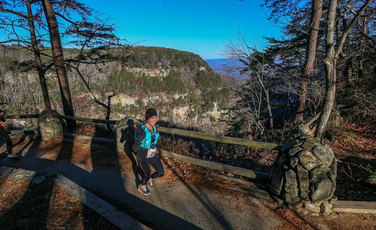Running a Different Kind of Race
January 19, 2021
"Penske Material" provides an inside look at some of the personalities, stories and moments that make Team Penske so unique.
Team Penske human resources representative Amber Wirth said her journey into long-distance running actually started with a passing comment by her supervisor.
 “When I started working at Team Penske my immediate boss, Terry Taylor, was an avid runner and cyclist,” Wirth said. “I was talking to him about running and I told him that I’d run 10 miles and he made a comment like, ‘If you can run 10 miles you can run a half marathon.’ That was a little bit of a challenge, so I decided to sign up for a half-marathon and I loved it!”
“When I started working at Team Penske my immediate boss, Terry Taylor, was an avid runner and cyclist,” Wirth said. “I was talking to him about running and I told him that I’d run 10 miles and he made a comment like, ‘If you can run 10 miles you can run a half marathon.’ That was a little bit of a challenge, so I decided to sign up for a half-marathon and I loved it!”
Now just a few short years later, Wirth has competed in 10 marathons, including prestigious events in New York City (2016), Chicago (2017) and Boston (2019). She also regularly competes in ultramarathons, which are defined as anything over 26.2 miles. The transformation of the mild-mannered HR rep to a tenacious long-distance runner able to conquer the mental and physical challenges of a 26.2-mile race is a perfect example of Penske Material.
 Wirth, who joined Team Penske in 2012, manages employee relations, which is no small task for the 400-person organization based in Mooresville, N.C. Recently, she has transitioned to the safety and environmental management side of human resources – an important area for the team, especially during the time of a global pandemic.
Wirth, who joined Team Penske in 2012, manages employee relations, which is no small task for the 400-person organization based in Mooresville, N.C. Recently, she has transitioned to the safety and environmental management side of human resources – an important area for the team, especially during the time of a global pandemic.
Wirth said she initially saw long-distance running as an outlet for her energic personality.
“I have a lot of energy and there’s not always a lot of ways to exert that with just standing still and sitting at a desk,” Wirth said. “(Running) is a way to combat that and get that energy out so there is that aspect of keeping my life in balance and keeping me calmer and mentally focused.”
 The differences between competing in one of the three major marathons and other long-distance races is significant, specifically the atmosphere and energy. Before the restrictions of COVID-19, the bigger races attracted 30,000-50,000 competitors, plus their families and supporters, which creates a buzz and excitement, even in a major metropolitan area.
The differences between competing in one of the three major marathons and other long-distance races is significant, specifically the atmosphere and energy. Before the restrictions of COVID-19, the bigger races attracted 30,000-50,000 competitors, plus their families and supporters, which creates a buzz and excitement, even in a major metropolitan area.
“The city itself is buzzing more than it normally is, and the atmosphere is tailored to us which is nice because it’s not normally it’s not like that,” Wirth said. “There are big crowds and when you’re running down the road there’s constant fanfare and cheering. It kind of spurs you along a little bit faster when you have that constant cheering.”
Running has given Wirth the opportunity to literally get a different view that other visitors don’t typically have the chance to experience.
“I have seen some amazing sights and some really great places and I’ve seen those places in a way that others might not because my abilities give me more opportunity,” she added. “When I ran the (New York City) marathon, I was in the middle of the road where I could see things that most people do not get to see because when they are in the middle of the road, they’ve got to cross really fast. I also got to see all five (New York) boroughs that way.”
 Her endurance training also led to an opportunity to see Machu Picchu, an Incan city set high in the Andes Mountains in Peru. The hike was approximately 50 miles over four days, something that would not have been possible for Wirth without her endurance training.
Her endurance training also led to an opportunity to see Machu Picchu, an Incan city set high in the Andes Mountains in Peru. The hike was approximately 50 miles over four days, something that would not have been possible for Wirth without her endurance training.
Even though she is a fierce and strong-willed competitor, Wirth admits to being a bit anxious before a marathon, but not for the reasons one might think.
“I do get those butterflies only because my goal going into the marathon is usually a certain time that I want to run,” Wirth said. “Like the races that I went into to qualifying for the Boston Marathon, I had specific time goals that I had to meet and with that the butterflies were a little bit different because there really was the need to perform, so you had butterflies from the fear of not being able to meet your goal plus the butterflies of knowing you were about to put your body through 26.2 miles of torture. When you’re going at certain speeds it can definitely wear and tear on your body, so you have butterflies of that anticipation and just the excitement of running it in general. It’s kind of nice to get through your training cycle and be able to do the finished product.”
Wirth competed in her first marathon near the home of Team Penske, in Charlotte, N.C., and she chose that event because of the challenging terrain. As she pushed through the physical challenges to finish the race, the joy and exhilaration she felt was briefly greater than the pain.
“I was extremely happy that I persevered and pushed through and actually finished when there were plenty of times that I wanted to stop,” Wirth said. “I chose that marathon to be my first because it has a lot of hills. Getting over the finish line knowing that I had conquered it, that was exhilarating and since it was a hometown marathon having my family there was really great. But after I crossed the finish line all the pain that I felt on the road it all came together and I don’t think I could walk straight for a week. It was painful.”
Wirth also likes the challenge of ultramarathons, which are contested on trails. In addition to the increased distance and location, the main obstacle that runners encounter is the mental toughness required to compete. According to Wirth, the big positive is the breathtaking scenery that most ultramarathon venues provide, but the distance is grueling, between 32 and 34 miles.
 “You don’t get any crowds cheering because being out on the trails, and there’s no way for family members and friends to get out there to see you,” Wirth said. “You’re out there with just your mind and your body to deal with.”
“You don’t get any crowds cheering because being out on the trails, and there’s no way for family members and friends to get out there to see you,” Wirth said. “You’re out there with just your mind and your body to deal with.”
The mental aspect of competing in marathons and ultramarathons can make the difference in finishing a race when the body is suffering from fatigue, according to Wirth.
“My training is there, physically,” Wirth said. “But when your physical starts to get a little tired, your brain has to pick up and your mental state has to be the one that says you’re going to finish this and so I think that at the end of it, (the mental aspect) is definitely most important.”
So what is the next challenge down the trail for Wirth?
“I’m actually in the middle of training for what’s called the Rim to Rim,” she divulged. “It is going from the South Rim of the Grand Canyon to the North Rim of the Grand Canyon and back. It’s at least 47.5 miles from side to side and almost 11 thousand feet of elevation gain and loss total. That’s my next big thing. I’m doing that in the spring of this year, so I’m in the middle of training for that.”
More Penske Material
Read more about the personalities, stories and moments that make Team Penske unique.



